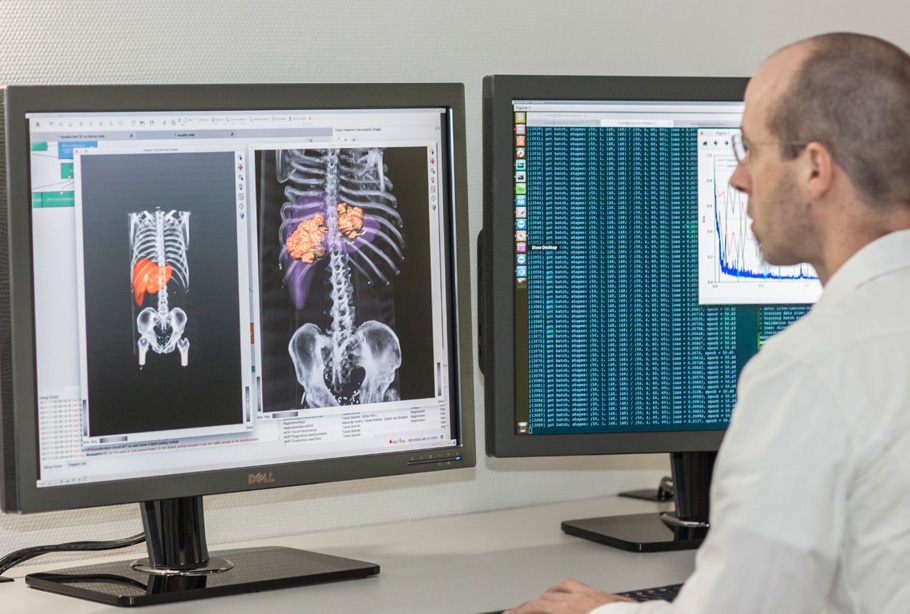Physicians and software developers team up to train a new AI platform
Fraunhofer MEVIS is directly involving doctors in the development of intelligent computer assistants for the clinical routine
Fraunhofer MEVIS is directly involving doctors in the development of intelligent computer assistants for the clinical routine
Annual Meeting 2017 of the Radiological Society of North America (RSNA) in Chicago: “Made in Germany” pavilion, stand 2565D

Bit by bit, computer assistants with the ability to learn are finding their way into hospitals and doctors’ practices. They support doctors during diagnosis and therapy planning. Until now, computer scientists played the primary role in designing and developing such ‘deep-learning’ algorithms. The Fraunhofer Institute for Medical Image Computing MEVIS in Bremen, however, is now developing AI systems in close cooperation with physicians. In Chicago on November 26, Fraunhofer MEVIS researchers will present their first promising results at RSNA 2017, the most important radiology congress in the world.
Cognitive computer assistants support physicians during long, monotonous, and recurring tasks, such as precisely determining organ contours on a CT image. Furthermore, these assistants can extract information from the image data that physicians cannot recognize merely by looking at the monitor with the naked eye.
What is special about these assistants is that they are able to learn. The more image data they process over time, the more precisely they can recognize organ contours in the images. “By continuously training the software, we increase its performance over time,” says MEVIS expert Markus Wenzel.
Until now, the performance of such assistants was often compared in the scope of special competitions. At the beginning of these challenges, all competing developer teams receive the same medical dataset. Image processing experts train their algorithms using these datasets. In the end, the software that can best accomplish the given task based on an independent dataset wins the competition. Because the algorithms are trained with the same dataset, the results can be easily compared. “But from a clinician’s point of view, these challenges often lack a connection to clinical applicability,” says Wenzel.
For this reason, the researchers in Bremen now integrate physicians very closely during software development. One example is a pilot project hosted by the Asklepios Clinic Barmbek in Hamburg. The main goal is to measure the liver volume during therapy in CT or MR images as precisely as possible. Experts want to determine, for instance, how repeated irradiation changes the size of an organ. Determining the volume of large, complex organs such as the liver is a time-consuming procedure for which a computer assistant could automatically recognize the organ in the image and measure its volume.
First, the specialists at the Barmbek clinic had to provide the technical prerequisites to implement the deep-learning system. “Ensuring that the algorithm can operate in a highly secure IT environment and access patient data is much more difficult at a community hospital than at a university clinic, where research based on patient data is routine.”
Improved versions of the AI platform can evolve from the computer assistant that the Fraunhofer experts initialized with a pool of jointly gathered image data. The participating physicians actively partake in the development as part of their everyday work. They regularly feed new cases from their routine into the software, review how the assistant processes new datasets, and correct its results. “This way, clinicians see what the computer has learned and can regularly give suggestions for optimization,” says Wenzel. “As developers, this helps us better respond to their needs and problems.” As a result, the computer assistant undergoes practical training and becomes increasingly efficient. “To be so directly involved with the development of such self-learning software assistants goes beyond a mere scientific fascination. It also helps me build trust in the capabilities of the software,” says Roland Brüning, Head of Radiology and Neuroradiology at the Asklepios Clinic Barmbek in Hamburg.
Important groundwork for the AI software platform had already been developed in the context of other MEVIS projects. In the SIRTOP project, experts in Bremen strove to accelerate and improve therapy planning for radio embolization, a special treatment method for liver tumors, with the help of elaborate computer algorithms. The AMI project aimed to develop self-learning computer algorithms that automatically search for abnormalities in medical image data to increase the accuracy of computer- generated diagnoses.
“Next year, we are going to develop our platform into a marketable product,” says Markus Wenzel. With this software, it will be possible to train an algorithm simultaneously and independently at different clinics and then fuse the results into a single software program. It will be able to consider knowledge gained from different clinics, which is imperative for larger, more complex cooperative projects.